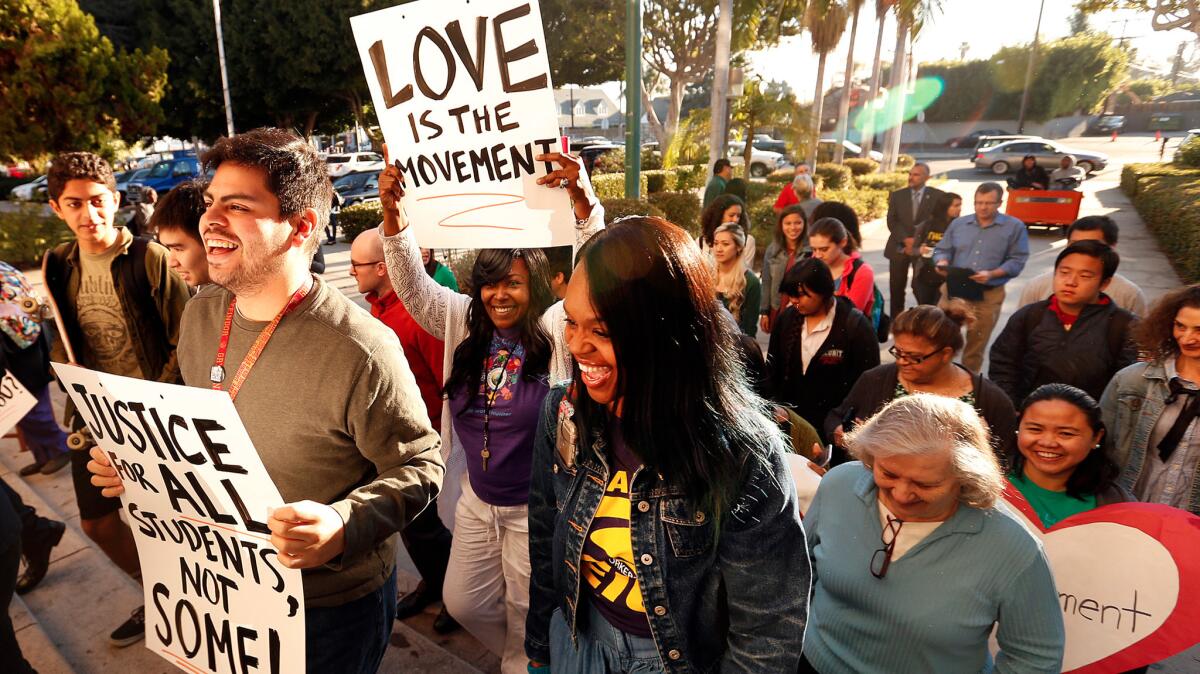Who gets to decide which L.A. public school campuses have to share space with charters?

- Share via
By the time parents find out that their kids’ school will share a campus with a charter school, the decision to put it there has usually already been made.
Los Angeles Unified School District board member Ref Rodriguez, a charter supporter who founded a network of charter schools in Los Angeles, frequently hears from parents unhappy that they were not involved in the process, or principals who say they feel as if they are being punished for declining enrollment. The charters, in turn, might have a difficult time at the host school because of the hostility. A charter school receives public funding, but may operate independently.
Now Rodriguez wants to form a committee of charter and district leaders who can figure out how to make colocation, the practice of putting both charter and traditional public schools on the same campus, a smoother experience for everyone. Results would include a guide for principals and a process to make sure communities know what’s coming.
A ballot measure passed in 2000, Proposition 39, dictates the process for allocating space to charters. Public school districts must provide available classroom space to charter schools.
Charter schools in L.A. apply for space by Nov. 1 each year, and receive their offers in April.
“Between November and April, no one’s talking to schools or communities,” Rodriguez said. The school board could create policies to inform communities as early as the summer that their school might be eligible for colocation, he said in a recent interview.
That way, if the available classrooms are a result of declining enrollment and a school’s leaders don’t want to share them, they can try to recruit more students, he said.
Enrollment in L.A. Unified has been declining for more than a decade because of several factors, including shifting demographics and the growth of charter schools.
Although L.A. Unified board president Steve Zimmer said he doesn’t think colocation is necessarily a good thing, the conversation should be centered around changing the law that requires it.
“It’s a bad law,” Zimmer said, speaking of Prop. 39. “Just because schools may technically have space ... doesn’t mean that’s the best solution for a charter school.”
See more of our top stories on Facebook >>
Karen Wolfe, a Venice parent whose children have been enrolled in charters and are now in traditional public schools, said colocation can get nasty, with resentment from parents at the traditional school, and a lack of regulation of the charters sharing the campus.
Wolfe recently co-founded PS Connect, a community group that helps inform parents about traditional schools and advocate for them.
Finding an impartial group of charter and public school leaders, as the resolution suggests, will be extremely difficult, she said.
“If you come to our schools you won’t find anyone sitting on that fence,” Wolfe told the board last Tuesday.
MORE EDUCATION COVERAGE
Black preschool kids still get suspended much more frequently than white preschool kids
Charter groups bridle at LAUSD’s order to ‘wand’ students to detect weapons
State says L.A. Unified spends improperly, must redirect hundreds of millions of dollars
Reach Sonali Kohli at [email protected] or on Twitter @Sonali_Kohli.
More to Read
Sign up for Essential California
The most important California stories and recommendations in your inbox every morning.
You may occasionally receive promotional content from the Los Angeles Times.











